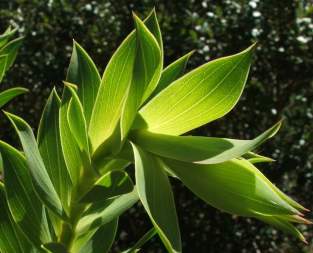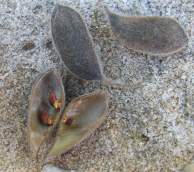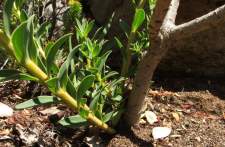Liparia splendens subsp. splendens
Liparia splendens (Burm.f.) Bos & De Wit subsp. splendens
Family: Fabaceae
Common names: mountain dahlia, orange nodding-head (Eng.), bergdahlia, geelkoppie, skaamblom (Afr.)
Introduction
Liparia splendens is a beautiful fynbos shrub with striking bright orange-yellow, nodding flowerheads in winter-summer, a rare find both in the wild and in gardens.

Description
Description
Liparia splendens ssp. splendens is a much-branched, upright, resprouting shrub, usually about 1 m tall.
Leaves are simple, alternate, sessile, hairless, elliptical and usually end in a sharp long point. The veins are prominent, and three or more primary veins arise from the base. Dead leaves dry black.

From autumn until summer (May-Jan) it bears large, rounded, nodding heads, up to 70 x 85 mm, at the tips of the branches. Each head consists of 15-17 bright orange to yellow flowers densely packed among conspicuous dark reddish-brown petal-like bracts. Should you wish to damage the beautiful head and remove a single flower to examine it more closely, you will find that the flowers possess all the elements of a typical papilionoid ("butterfly-like") legume flower. That is, five petals: a large standard petal, two lateral wing petals and the two lower petals joined along their lower margin to form the keel that encloses the stamens and pistil. In Liparia splendens the wing petals are unusual in that they are folded around the keel with interlocking lobes. There are 10 stamens, 1 is free and the other 9 are fused to form a short open tube. The style is longer than the stamens so that the stigma sticks out slightly beyond the anthers.

Seeds are brown, bean-shaped, ±6 mm long and ±3 mm wide, and the pods are ± 30 mm long and hairy. The pods split explosively to release the seeds.

Liparia splendens is divided into two subspecies: subsp. splendens and subsp. comantha. To tell them apart, examine the edges of the flower-bearing bracts and lower calyx lobes; in subsp. splendens more than half of the circumference is hairless, whereas in subsp. comantha more than half of the circumference is hairy. The flowerheads of subsp. comantha are also marginally smaller (up to 60 x 70 mm) than those of subsp. splendens (up to 70 x 85 mm).
Conservation Status
Status
Liparia splendens ssp. splendens is classified as Vulnerable on the Interim Red Data List. The greatest threat is to the populations in lowland fynbos, as lowland fynbos is seriously threatened by urban development and agriculture. Liparia splendens is listed as Schedule 4 Protected Flora according to Western Cape Nature Conservation Laws Amendment Act, 2000.
Distribution and habitat
Distribution description
Liparia splendens ssp. splendens is found in mountain and lowland fynbos growing on rocky hills and mountain slopes, often on the cooler, damper side of mountains, at 20-1000 m, in soil derived from Table Mountain sandstone. It occurs on the Cape Peninsula and Cape Flats, south of Paarl and west of the Hottentots Holland. Plants can be seen growing wild on the slopes of Table Mountain above Kirstenbosch. Liparia splendens subsp. comantha occurs east of the Hottentots Holland Mountains, from Somerset-West, to Caledon, Bredasdorp, Swellendam and Riversdale to Albertinia.

Derivation of name and historical aspects
History
Although, as its common name suggests, it resembles a dahlia, Liparia splendens is not related to dahlias at all. Dahlias belong in the daisy family (Asteraceae) while Liparia is a member of the legume family (Fabaceae), a large diverse family of 650 genera and some 18 000 species.
The genus Liparia is named from the Greek liparos meaning oily or shiny or brilliant, referring either to the hairless (shiny) leaves or the brilliant flowers. The species name splendens is Latin and also means to shine, be bright or radiant, or distinguished - or in a word: splendid! The common name skaamblom means 'shy flower', alluding to the way it shyly bows its flowerheads, and the name geelkoppie meaning 'little yellow head' refers to its showy head ( koppie ) of yellow-orange flowers.
Liparia splendens first appeared in literature in 1704, in John Ray's Histora Plantarum under the name Genista africana rusci foliis etc. (Bos). Ray got his plant material from Sherard, which implies that the plant described was already growing in Sherard's garden, most likely raised from seed imported at an earlier date. It next appears in the Prodromus Flora Capensis (1768) published by N.L. Burmann under the name Leucadendron splendens, incorrectly placed in Proteaceae (Bos). This publication was based on the collection of Cape plants of his father, J. Burmann. The first publication of Liparia as a new genus was by Linnaeus in the second Mantissa of 1771 (Bos). He gave an extensive generic description and described six species with Liparia sphaerica as the type species.
A colour illustration of Liparia sphaerica was published in Curtis's Botanical Magazine in 1809 (reproduced on the Aluka website). More species were proposed over the years until 1825 when De Candolle studied all the material and excluded all but one species from Liparia and placed the rest into the genera Priestleya, Rafnia or Borbonia. It was during this study that De Candolle established that Burmann's Leucadendron splendens and Linnaeus' Liparia sphaerica were one and the same. Burmann's name is the earlier one, and therefore takes precedence, which is why this species is now called Liparia splendens and Liparia sphaerica is a synonym. When J.J. Bos revised the genus in 1967, he accepted De Candolle's concept of the genus, describing only two species: L. splendens, divided into the two subspecies, and L. parva.
But, the story does not end there. In 1991 Van Wyk, Verdoorn and Greinwald published their results on comparative analyses of the alkaloids in Liparia splendens and L. parva. Although the two species look similar, they contain different alkaloid patterns, which shows that they are considerably different. The two species also show structural differences in their inflorescence and flowers and it is thought that adaptation to different pollination mechanisms by the two species is what has led to the wide gap between them.
Liparia parva with its hidden flowers at ground-level, similar in colour and odour to mammal-pollinated proteas, is most likely mammal pollinated, while Liparia splendens has adapted to bird pollination. This study led to the 1994 re-evaluation of the generic delimitation of Priestleya and Liparia by Schutte and Van Wyk and the 1997 revision by Schutte. Until then, it was the shape and size of the keel petals and number of flowers per inflorescence that was used to separate the species. But, the unique combination alkaloids they share, as well as other distinctive characteristics, shows that they are actually one genus, and the differences in the flowers and inflorescences are caused by adaptations to different pollination strategies. Priestleya was therefore returned to Liparia in which 20 species are now recognized.
All Liparia species are found only in the fynbos biome with the highest concentration of species in the southwestern Cape. Only one species distribution extends beyond the Western Cape into the Eastern Cape.
Ecology
Ecology
Liparia splendens is visited by both sunbirds and carpenter bees in search of nectar, but the pollinator is the sunbird. When the sunbird pushes its head between the petals to get to the nectar, it causes the stamens and style to pop out from the enclosing keel petals, which puts the pollen-bearing anthers and the stigma in contact with the bird's throat feathers. The bird then carries this pollen to the next flowerhead and repeats the process to bring about cross-pollination.
Liparia seeds have a fleshy collar-like aril that attracts ants. The ants carry the seeds away to their nests to consume the aril, dispersing the seeds in the process. This is known as myrmecochory.
Fynbos is fire adapted and plants have developed different strategies to survive fires, the main two being reseeding and resprouting. Liparia splendens is a resprouter. When a fire sweeps through a population the above ground parts are killed but it has a large underground rootstock, known as a lignotuber, which survives and sends out vigorous new growth soon after the fire. Resprouters are usually multi-stemmed at ground level. Reseeders are usually single-stemmed at ground level and the whole plant is killed by the fire, but they produce large amounts of seed that germinate en masse after a fire.

Liparia splendens like many legumes, possesses root nodules that fix nitrogen in the soil.
During his study, Bos discovered a slug-like insect exactly resembling a leaf on a freshly picked Liparia splendens subsp. comantha specimen from Sir Lowry's Pass area. It was identified as a caterpillar of unusual habit. A second specimen was found and fed on fresh leaves of both subspecies until it proceeded to pupate and hatch into a moth that was identified as Homosusica eugrapha.
Uses
Use
Liparia splendens is not used medicinally nor is it commonly cultivated.
Growing Liparia splendens subsp. splendens
Grow
It is not easy to grow this fynbos shrub, but success can be achieved by mimicking its habitat. It likes well-drained, quartzitic, acidic soil, and does best amongst rocks. It needs ample water during autumn-winter-spring and some water during the summer, and it must drain away - soggy soil is sure to cause the rootstock to rot. It also prefers free movement of air and may be more prone to fungal infection in a still, humid position. It does well in full sun or half-day shade.
Grow it in a rockery, or on a rocky slope or embankment in well-drained, sandy soil. Mulch with well-rotted compost applied in spring and autumn and feed with an organic fertiliser. When the plant is established, pinch the tips to encourage branching. When well established, take out the older stems to encourage thickening of the rootstock and new stems to sprout from the rootstock. Old plants (8+ years) can get lanky and scrappy.
Fire has a rejuvenating effect on older plants. To rejuvenate an older garden plant, mimic a fire by cutting the old woody stems right back to the rootstock, but leave a few of the younger stems. This heavy pruning is best done in late summer, just before the rainy season begins in autumn, when the plant should resprout vigorously from the rootstock.
Liparia splendens is sensitive to frost and in cold climates is best grown in a cool, dry glasshouse suited to temperate Mediterranean flora. When growing Liparia splendens in a glasshouse, refrain from watering directly on the leaves or in the evening, as this may cause fungal infections. We have not tried long-term cultivation in containers. Liparia splendens may do well in a container, provided the soil is sandy and well-drained, it is placed in a well-ventilated area that is not too hot, and it is not overwatered.
Liparia splendens can be propagated from seed or cuttings.
From seed, first select the viable seeds by throwing them in a cup of water, the viable seeds will sink and the duds float. Best results are obtained if the seed is scarified to weaken the seed coat. This can be achieved by sandpapering each seed, or using a sharp blade to make a shallow cut into the seed coat or slicing a small piece of the seed coat off, but take care not to damage the embryo inside. Researchers at Kirstenbosch developed an ingenious method of sandpapering batches of seed: line a ± 10 cm diameter length of tube with coarse sandpaper, seal one end, put the seeds inside, plug the other end and shake them about inside, or use a paddle or stirring rod inside the tube to rub the seeds against the wall.
Next soak the seed overnight in hot water (not boiling - use water that will not scald your hand). Seed should then be sown, in late summer to autumn (March-April-May), in sterile, well-drained medium and kept warm and moist until germination. It is crucial that they be watered with a fungicide that combats both pre- and post-emergence damping off.
Germination from treated seed should take about 6 weeks. Without these treatments, you will find that many seeds swell but don't germinate, and those that germinate will either not make it to the surface (pre-emergence damping off) or will fail to thrive and die soon after producing apparently healthy cotyledons (post-emergence damping off). Another tip to increase the number of surviving seedlings is to minimise the root disturbance by sowing the seed in plugs or small containers, or to transplant the seedlings very early, while still in the cotyledon stage.
Cuttings can be taken late summer to autumn or spring to early summer. Best results are obtained from semi-hardwood growth straight from the rootstock - look for thin, new shoots at the base of the plant, and get a heel off the rootstock. Alternatively, take semi-hardwood tip cuttings. Treat with rooting hormone suitable for semi-hardwood material, plant in sterile, well-drained medium e.g. milled bark and polystyrene, and place in a mist unit with bottom heat ( ± 24 o C). As with seedlings, to minimise root disturbance plant the cuttings into plugs or small containers.
References
- Bos, J.J. 1967. The genus Liparia L. (Pap). J SA Bot 33(4):269-292.
- Van wyk, B-E., Verdoorn, G.H. & Greinwald, R. 1991. Taxonomic significance of alkaloids in the genus Liparia (Fabaceae - Liparieae). S.Afr.J.Bot 57(6): 344-347.
- Schutte, A.L. & Van Wyk, B-E. 1994. A Reappraisal of the Generic Status of Liparia and Priestleya (Fabaceae). Taxon 43: 573-582.
- Schutte, A.L. 1997. Systematics of the genus Liparia (Fabaceae). Nord.J.Bot 17:11-37.
- Grobbelaar, N., van Rooyen, M.W.and van Rooyen, N.. 1983. A qualitative study of the nodulating ability of legume species: List 6. S. Afr. J. Bot. 2: 329-332.
- Goldblatt, P. & Manning, J. 2000. Cape Plants, A Conspectus of the Cape Flora of South Africa. National Botanical Institute, Pretoria & Missouri Botanical Garden Press, Missouri.
- Manning, J. 2007. Field Guide to Fynbos. Struik Publishers, Cape Town.
- Maytham Kidd, M. 1983. Cape Peninsula, South African Wild Flower Guide 3, New Edition. Botanical Society of South Africa, Cape Town
- Jackson, W.P.U. 1977. Wild Flowers of Table Mountain. Howard Timmins (Pty) Ltd, Cape Town.
- Smith, C.A. 1966. Common names of South African plants. Memoirs of the Botanical Survey of South Africa No. 35.
- Jackson, W.P.U. 1990. Origins and Meanings of Names of South African Plant Genera. U.C.T. Printing Dept., Cape Town.
- Leistner, O.A. (ed.). 2000. Seeds plants of southern Africa : families and genera. Strelitzia 10. National Botanical Institute, Pretoria.
- Western Cape Nature Conservation Laws Amendment Act, 2000 can be downloaded at http://www.capenature.org.za/docs/416/Western%20Cape%20Nature%20Conservation%20Laws%20Ammendment%20Act%202000.pdf
- Original illustration of Liparia sphaerica from Curtis's Botanical Magazine can be viewed on Aluka http://www.aluka.org
Credits
Alice Notten
Kirstenbosch National Botanical Garden
March 2008
Acknowledgements: the author thanks Anthony Hitchcock for sharing his experience of growing and propagating Liparia splendens.
Plant Attributes:
Plant Type: Shrub
SA Distribution: Western Cape
Soil type: Sandy, Loam
Flowering season: Spring, Early Summer, Autumn, Winter
PH: Acid
Flower colour: Red, Yellow, Orange
Aspect: Full Sun, Morning Sun (Semi Shade)
Gardening skill: Challenging
Special Features:
Horticultural zones









Rate this article
Article well written and informative
Rate this plant
Is this an interesting plant?
Login to add your Comment
Back to topNot registered yet? Click here to register.